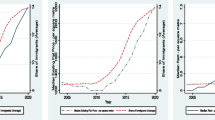Conclusions
We started this paper from the widely accepted hypothesis that there is a significant price bias in socialist economies which undervalues investment as compared with market economies, but a comparison of the deviations of linear model prices (production prices, extended production prices, cost prices, and labour value prices) from actual prices in Austria and Hungary does not support this hypothesis:
-
1)
The deviations of actual aggregated prices from linear model prices of both countries are very similar (r=0.85).
In both countries basic and food industries make profits which are smaller than average, while more dynamic industries with a higher share in new products obtain above average profits.
-
2)
At production prices and extended production prices the relative price effect is stronger than the turnover tax effect and runs counter to it. Since this is the case in both countries it cannot be concluded that the share of investment in national income is distorted on the low side in Hungary.
Similar content being viewed by others
References
T. P. Alton: Economic Structure and Growth in Eastern Europe; Economic Development in Countries of Eastern Europe, Washington 1970.
W. J. Baumol and D. F. Bradford: Optimal Departures from Marginal Cost Pricing, American Economic Review60 (1970), pp. 265–283.
A. Bergson: The Real National Income of the Soviet Russia Since 1928, Cambridge 1961.
A. Bergson and S. Kuznets (ed.): Economic Trends in the Soviet Union, Cambridge, Mass. 1963.
M. Bornstein: Price Formation Models and Price Policy in Hungary, in A. Abouchar (ed.): The Socialist Price Mechanism, Durham, North Carolina 1977, pp. 231–245.
M. Bornstein and D. R. Fusfeld (ed.): The Soviet Economy, A Book of Readings, 3rd ed. Homewood (Ill.), 1970.
A. A. Brown and D. O. Walker: Hungarian Input-Output Tables: Description, Reconstruction and Price Adjustment, Indiana University, Bloomington, Working Papers No. 20, 1973.
A. A. Brown, O. P. Hall, and J. A. Licari: Price Adjustment of Input-Output Tables for Socialist Economies: Theory and an Empirical Technique: University of Windsor, Discussion Paper Series No. 10, Canada 1972.
A. A. Brown, O. P. Hall, and J. A. Licari: Price Adjustment Models for Socialist Economies: Theory and an Empirical Technique, Studies in East European and Soviet Planning, Development and Trade No. 18, 1973.
A. A. Brown and J. A. Licari: Price Formation Models and Economic Efficiency, in: A. Abouchar (ed.): The Socialist Price Mechanism, Durham, North Carolina 1977, pp. 184–230.
A. Brody: Proportions, Prices and Planning, Amsterdam 1970.
A. M. Costa: The Duality Properties of the Interindustry Eigenmodel. A Test Case: The Soviet Debate on the Development Strategy and the Law of Value. European Meeting of the Econometric Society, Budapest, September 1972.
B. Csikos-Nagy, S. Gancer, and J. Racz: Az elsö termerkrend szeru armodell, Közgazdasagi Szemle1 (1964), pp. 17–35.
Economic Reforms and the Revision of Wholesale Prices, Sotsialisticheskaya industriya, August 28, 1979 (RFE-RL 345/79).
J. Fáy and G. Fink: Ein Input-Output-Vergleich der Struktur der Bruttoproduktion nach Wirtschaftsbereichen zwischen Österreich und Ungarn, Wiener Institut für Internationale Wirtschaftsvergleiche, Forschungsbericht Nr. 35, 1976.
G. Fink and J. Skolka: Capital and Labour Intensity in Austrian and Hungarian Foreign Trade — an Input-Output Comparison, Jahrbuch der Wirtschaft Osteuropas9 (1980).
G. Heal, G. Hughes, and R. Tarling: Linear Algebra and Economics, London 1974.
L. Hejl, O. Kýn, and B. Sekerka: A Model for the Planning of Prices, in: C. H. Feinstein (ed.): Socialism, Capitalism and Economic Growth, Cambridge 1967, pp. 101–124.
L. Hejl, O. Kýn, and B. Sekerka: Model cenových typů, Rozpravy CCAV, Academia, Prague 1969.
O. Kýn: On International Comparisons in Artificial Prices, Wiener Institut für Internationale Wirtschaftsvergleiche, Forschungsberichte Nr. 15, 1974.
M. Morishima: Prices, Interest and Profits in a Dynamic Leontief System, EconometricaXXVI (1958), pp. 358–380.
V. Nesvera: Investitionen in Österreich und in der Tschechoslowakei, Studien über Wirtschafts- und Systemvergleiche, Band 1, Wien, New York 1971.
D. M. Nuti: Transformation of Labour Values into Production Prices and the Marxian Theory of Exploitation, Economista (1974), No. 1, pp. 27–48.
J. Osiatynski: On the Price-Bias in Comparative Analysis of Planned and Market Economies: Wiener Institut für Internationale Wirtschaftsvergleiche, Forschungsbericht Nr. 13, 1974.
F. Seton: The Transformation Problem, The Review of Economic Studies24 (1957), pp. 149–160.
D. O. Walker: Socialist Price Formation Models and the Hungarian Economy, Indiana University, Bloomington, Studies in East European and Soviet Planning, Development and Trade No. 19, 1973.
Author information
Authors and Affiliations
Additional information
I wish to thank the Fonds zur Förderung wissenschaftlicher Forschung in Vienna for financial support, and among others O. Kýn, K. Laski, J. Richter, J. Skolka, and P. Wiedemann for helpful comments on earlier drafts of this paper. The responsibility for remaining errors is mine alone.
Rights and permissions
About this article
Cite this article
Fink, G. Price distortions in the Austrian and in the Hungarian economy. Zeitschr. f. Nationalökonomie 41, 111–132 (1981). https://doi.org/10.1007/BF01283112
Received:
Revised:
Issue Date:
DOI: https://doi.org/10.1007/BF01283112




